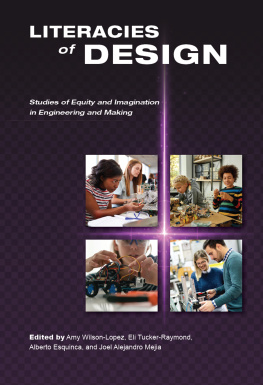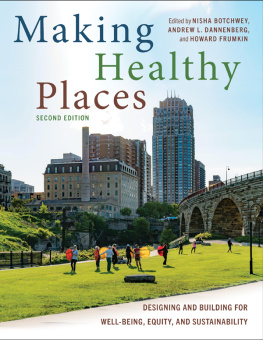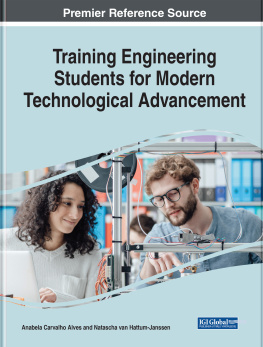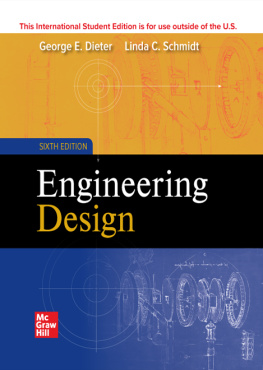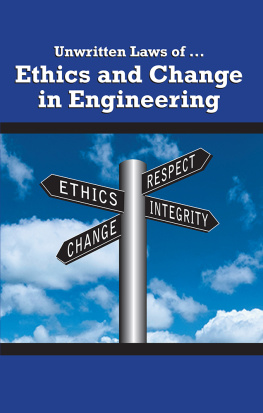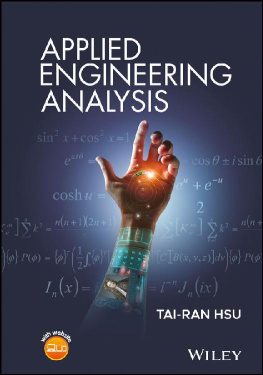Contents
Page List
Guide

LITERACIES of DESIGN
Copyright 2022 by Purdue University. All rights reserved.
Printed in the United States of America.
Cataloging-in-Publication Data is available at the Library of Congress.
978-1-61249-744-0 (hardback)
978-1-61249-745-7 (paperback)
978-1-61249-746-4 (epub)
978-1-61249-747-1 (epdf)
Cover image: Building her own robotic car by StockRocket / iStock / Getty Images Plus via Getty Images; Young attractive students of mechatronics working on project by nd3000 / iStock / Getty Images Plus via Getty Images; Two Female College Students Building Machine In Science Robotics Or Engineering Class by monkey-businessimages / iStock / Getty Images Plus via Getty Images; Knowledge is power. African American boy looking at detail while making toys at a technology class by LanaStock Photographer Name / iStock / Getty Images Plus via Getty Images; Purple laser beam light effect isolated on transparent background by Likanaris/ iStock / Getty Images Plus via Getty Images
CONTENTS
Amy Wilson-Lopez, Alberto Esquinca, Joel Alejandro Mejia, and Eli Tucker-Raymond
Salem R. Metzger, Alison K. Mercier, and Heidi B. Carlone
Lynn E. Shanahan, Mary B. McVee, and Katarina Silvestri
Gabriel DellaVecchia and Annemarie Sullivan Palincsar
Alberto Esquinca and Lidia Herrera-Rocha
Patricia Paugh, Kristen Wendell, and Christopher Wright
Michelle E. Jordan
Amy Wilson-Lopez, Karen Hazel Washburn, and Indhira Mara Hasbn
Edna Tan and Angela Calabrese Barton
Eli Tucker-Raymond, Brian E. Gravel, Susan Klimczak, Aditi Wagh, and Ada Ren-Mitchell
Jasmine Nation, David Saosa, Joi Duncan, and Richard Durn
Virginia Killian Lund and Nathan C. Phillips
Jessica M. Smith and Juan C. Lucena
Joel Alejandro Mejia and Renata A. Revelo
INTRODUCTION
Literacies and Design for Equity
AMY WILSON-LOPEZ,
Boston University
INTRODUCTION
Engineering design has resulted in the implementation of many technologies and systemsfrom water distribution systems to vaccineswhich result in life-altering consequences for individuals, communities, and societies. Unfortunately, access to technologies, and benefits from those technologies, continue to disproportionately favor dominant groups while disadvantaging historically marginalized groups. To address the inequitable consequences of technologies in society, several scholars and educators have begun to explore how learning environments, as enacted in formal and informal settings, can provide children, teens, and adults with opportunities to imagine and design new technologies and systems that result in more equitable consequences in their personal lives and in broader community and societal contexts. In addition to advancing equitable consequences, these learning environments also insist upon equitable learning processes, such as opportunities for minoritized youth to be recognized as powerful contributors and designers.
Equitable learning processes cannot be enacted in learning environments that devalue learners home languages or representational practices. All too often, standard English or academic English is promoted within engineering courses, but scholars (Baker-Bell, 2020; Flores & Rosa, 2015) have argued that these terms mask the fact that the standard tends to be linguistic forms valued by those in dominant groups. Consequently, the term White Mainstream English, instead of standard English, should be used to acknowledge that, just as people see race, they hear race too, when they position White Mainstream English as the standard and all other linguistic forms as comparatively deficient (Alim & Smitherman, 2012; Flores, 2020). Thus, racial equity in making and engineering education encompasses more than designing technologies that promote equity. It also includes honoring and sustaining learners oral and written languages and representational practices as core resources for imagining, reasoning, knowing, and doing at all times (Garca & Kleyn, 2016). In this way, embracing and leveraging multiple language and literacy practices are essential to learning environments that emphasize equity in both process and outcome.
This book brings together scholars and educators whose work addresses a broad range of learners and educators at different intersections of equity, literacies, and design in engineering and making. The authors offer suggestions for educators in school-based and out-of-school contexts to foster equity-oriented educational practices that integrate multiple literacies and design. They also advocate for greater responsiveness in support of people who are positioned at the margins of participating in design and who have been adversely affected by the consequences of designed technologies and systems. In the remainder of this introductory chapter, we define core themes within the book, and specify possible relationships among design, literacy, and equity in engineering and making; we then summarize how subsequent chapters illuminate these relationships in different ways.
CORE THEMES OF THE BOOK
This book brings together three themes related to learning and teaching through design: (a) pluralistic and inclusive views of literacies and design in engineering and making should be embraced, (b) literacies are essential to design practices, and (c) design can perpetuate or dismantle inequities. First, an inclusive and pluralistic vision of design prioritizes the realities of many individuals living on the margins of decision-making processes while focusing on their dignity, empowerment, and security. When enacting an inclusive and pluralistic approach, designers intentionally consider the contexts in which designs might be used, and they foreground the perspectives and interests of minoritized groups who have a rightful voice in the creation of designs. Inclusive and pluralistic learning environments embrace a wide range of culturally-derived bodies of knowledge and practices throughout the process of envisioning and realizing designs in engineering and making. The chapters in this book collectively highlight pluralistic and inclusive approaches to design by describing how people from different ages, races and ethnicities, genders, and educational backgrounds engage in critical and creative learning and action through diverse design and literacy practices in engineering and making.
Second, literacy practices are essential to learning, creating, and evaluating designs in the context of engineering and making. People use a variety of literacy practices, including the interpretation and production of texts, to effect change in relation to the designed world. The scholarly contributions in this book show how textual interpretation and production enable the identification of problems and spark ideas for further innovation. Throughout this book, the authors illustrate and explain additional synergistic connections between literacies and design as practiced by different groups engaged in engineering or making. These authors illustrate that literacy practices and design practices are dynamic and interrelated as people seek to realize new possibilities or effect change.
Third, designincluding its embedded literaciescan perpetuate or dismantle inequities in society. Historically, the products of design have not been equitable in their consequences because they have not benefited all groups proportionately. Opportunities for learning and doing design have also been inequitable. This book addresses how learners can use literacy practices not only to recognize and critique products of design that are inequitable in their consequences, but also participate in creative practices that contribute to a better world.

